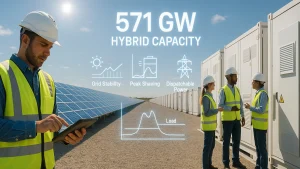2025 Interconnection Queue: How EPCs Beat Grid Delays

2025 Interconnection Queue Updates: How EPCs Can Reduce Grid Connection Delays
What Is the Current State of the U.S. Interconnection Queue in 2025?
The U.S. interconnection queue has reached a critical bottleneck in 2025, with over 2.6 terawatts of generation and storage capacity actively seeking grid connection. This represents more than twice the total installed capacity of the existing U.S. power fleet, creating unprecedented challenges for solar EPCs nationwide.
Quick Answer: The interconnection queue backlog has grown 30% since 2023, with solar projects representing over 1,080 GW of total capacity. However, only 14% of solar projects historically complete the interconnection process successfully.
The Numbers That Define the Crisis
According to Lawrence Berkeley National Laboratory’s latest “Queued Up” report, the interconnection landscape presents these stark realities:
- 2.6 TW total capacity seeking grid connection
- 95% renewable energy projects dominate the queues
- 5-year average wait time from request to commercial operation
- Only 10% success rate for projects expected to come online in the next three years
- $2 trillion estimated total investment value of queued projects
Why Are Interconnection Delays Getting Worse for Solar EPCs?
The interconnection crisis stems from multiple converging factors that directly impact EPC project timelines and profitability.

Primary Causes of Delay
Infrastructure Constraints: The existing transmission grid cannot accommodate the surge in renewable energy projects without significant upgrades.
Regulatory Bottlenecks: Despite FERC Order 2023 reforms, implementation remains inconsistent across different grid operators and regions.
Application Quality Issues: Grid operators report that over 90% of interconnection applications contain deficiencies, requiring multiple revision cycles.
Resource Limitations: Transmission system operators lack sufficient staff and analytical tools to process the unprecedented volume of requests efficiently.
How Can Solar EPCs Reduce Grid Connection Delays?
Success in today’s interconnection environment requires strategic approaches that go far beyond traditional project development methods.
1. Master the Art of Site Selection and Grid Analysis
Pre-Development Grid Assessment
Before committing to any site, successful EPCs conduct comprehensive grid capacity studies that evaluate:
- Existing transmission capacity and known constraints
- Historical interconnection success rates in the target area
- Proximity to substations with available capacity
- Potential for costly network upgrade requirements
Pro Tip: Leverage Enverus’s machine learning models and similar tools to assess interconnection probability before entering the queue. This data-driven approach can save months of wasted effort.
2. Perfect Your Interconnection Application Strategy
The 90% Rule: Application Excellence
Since most applications are deficient, EPCs can gain significant competitive advantage through submission quality.
Application Excellence Checklist:
- Complete site control documentation with proper legal review
- Accurate electrical specifications and professional engineering drawings
- Environmental assessments and preliminary permitting status
- Financial readiness demonstration with banking relationships
- Utility coordination documentation and communication records
Strategic Timing Considerations:
- Submit during optimal queue cycles when possible
- Coordinate with FERC Order 2023 implementation timelines
- Consider fast-track eligibility for smaller projects
3. Navigate Regional Market Differences
Understanding Grid Operator Variations
Not all interconnection markets are created equal. Smart EPCs focus their efforts where success rates are highest.
Best-Performing Markets:
- ERCOT (Texas): 1-2 year timeline using “connect and manage” approach
- Some CAISO regions: Implementing queue reforms showing improvement
Most Challenging Markets:
- PJM Interconnection: 46-79% suspension rates during final phases
- NYISO: Complex procedures with extended timelines
- ISO New England: Similar high suspension rates
4. Leverage Emerging Technology Solutions
AI-Powered Interconnection Tools
The Biden-Harris Administration’s $30 million AI4IX program is developing artificial intelligence solutions that EPCs should monitor:
- AI-powered application review systems for quality checking
- Automated deficiency identification before submission
- Machine learning success probability models
- Enhanced study coordination platforms
What Are the Most Effective EPC Contract Strategies for Interconnection Risk?
Managing interconnection uncertainty requires sophisticated contract structures that protect both EPCs and project owners.

Risk Allocation Best Practices
Owner Responsibility Framework:
- Interconnection approvals and regulatory delays
- Network upgrade cost responsibilities
- Permit timing and regulatory compliance
EPC Protection Mechanisms:
- Change order provisions for scope modifications
- Milestone adjustment clauses based on interconnection timing
- Force majeure coverage for regulatory delays
- Pass-through provisions for utility-imposed charges
Fixed-Price vs. Cost-Plus Considerations
When to Use Fixed-Price Contracts:
- Sites with well-understood grid conditions
- Projects with completed interconnection studies
- Experienced EPC teams with strong regional knowledge
When Cost-Plus Makes Sense:
- Uncertain interconnection requirements
- Early-stage queue positions
- Complex hybrid or storage integration projects
How Do Hybrid Solar-Plus-Storage Projects Perform in Interconnection Queues?
Solar-plus-storage projects represent 571 GW of hybrid capacity in current queues, offering several strategic advantages for EPCs.

Benefits of Hybrid Project Development
Enhanced Grid Value Proposition:
- Improved capacity factors and grid services
- Reduced curtailment risk during high solar production
- Multiple revenue streams from energy and ancillary services
- Potential for expedited utility review processes
Technical Advantages:
- Shared interconnection infrastructure reduces costs
- Grid stability benefits may accelerate approval
- Flexibility to optimize energy delivery timing
What Role Do Grid Enhancement Technologies Play in Reducing Delays?
Grid Enhancement Technologies (GETs) represent a promising solution for increasing transmission capacity without building new lines.
Key Technologies EPCs Should Understand
Power Flow Control Devices: Enable dynamic routing of electricity to maximize existing line capacity.
Dynamic Line Rating Systems: Allow transmission lines to carry more power during favorable weather conditions.
Advanced Conductors: Retrofit existing transmission lines with higher-capacity materials.
According to studies by The Brattle Group, these technologies could effectively double grid capacity in Kansas and Oklahoma by 2025.
How Is FERC Order 2023 Changing Interconnection Procedures?
FERC Order 2023 represents the most significant interconnection reform in decades, fundamentally changing how projects enter and progress through queues.
Key Changes Taking Effect
Cluster-Based Processing: Replaces first-come, first-served with grouped project analysis, improving study efficiency.
Enhanced Financial Requirements: Higher deposits and readiness demonstrations reduce speculative projects.
Stricter Timelines: Grid operators face penalties for missing study deadlines, improving predictability.
Improved Cost Allocation: More equitable distribution of network upgrade costs among benefiting projects.
What Financial Strategies Help EPCs Manage Interconnection Uncertainty?
Interconnection delays create significant financial risks that require proactive management strategies.
Cost Impact Analysis
Direct Cost Implications:
- Carrying costs during extended queue periods (typically $50,000-$200,000 per MW annually)
- Equipment price escalation risks
- Tax credit timing optimization challenges
- Revenue recognition delays affecting project financing
Risk Mitigation Approaches
Portfolio Diversification: Spread risk across multiple queue positions and regions to improve overall success probability.
Contingent Financing: Structure deals with financing milestones tied to interconnection approval rather than fixed dates.
Hedging Strategies: Protect against commodity price exposure during extended development periods.
Insurance Products: Evaluate interconnection delay coverage where available from specialized insurers.
How Can EPCs Optimize Their Interconnection Performance Metrics?
Data-driven approaches to interconnection management yield measurably better results.
Key Performance Indicators (KPIs) to Track
Success Rate Metrics:
- Interconnection approval rate by region and grid operator
- Average queue time from application to final approval
- Application deficiency rates and revision cycles
- Network upgrade cost frequency and magnitude
Financial Performance Indicators:
- Cost per MW for successful interconnections
- Revenue impact of interconnection delays
- Portfolio-level success rates across multiple projects
Operational Excellence Measures:
- First-submission approval rates
- Timeline prediction accuracy
- Stakeholder relationship quality scores
What Does the 2025 Interconnection Outlook Mean for EPC Strategy?
The interconnection landscape continues evolving rapidly, requiring adaptive strategies from successful EPCs.
Positive Market Developments
Regulatory Progress:
- FERC Order 2023 implementation across most markets
- DOE’s i2X program providing $16 million in funding support
- State-level queue transparency initiatives in all 50 states
- Technology solution adoption accelerating industry-wide
Market Drivers Supporting Growth:
- Continued strong corporate renewable energy demand
- Federal and state policy support through 2030
- Declining solar and storage technology costs
- Enhanced grid modernization investments
Persistent Challenges Requiring Attention
Structural Market Issues:
- Transmission infrastructure investment needs estimated at $30-50 billion annually
- Permitting and siting constraints for major transmission projects
- Skilled workforce shortages in grid analysis and planning
- Supply chain resilience concerns affecting equipment timing
Best Practices for EPC Success in the 2025 Interconnection Environment
Pre-Development Excellence
Comprehensive Feasibility Framework:
- Grid capacity analysis using latest available data
- Early utility engagement and relationship building
- Regulatory compliance verification across all jurisdictions
- Environmental and cultural resource assessment completion
Queue Entry Strategy
Application Quality Assurance Process:
- Multi-stage internal review before submission
- Third-party engineering validation of technical specifications
- Legal review of all documentation and agreements
- Financial readiness verification with banking partners
Construction Phase Preparation
Flexible Project Management:
- Construction scheduling with interconnection delay contingencies
- Supply chain management allowing for timeline adjustments
- Workforce planning accommodating potential schedule changes
- Quality control systems ensuring first-time utility acceptance
Conclusion: Navigating the Interconnection Challenge Successfully
The 2025 interconnection queue crisis represents both the greatest challenge and opportunity facing solar EPCs today. While delays and complexity continue increasing, EPCs implementing comprehensive strategies consistently achieve better outcomes.
Essential Success Factors:
- Quality-First Approach: Excellent applications outperform rushed submissions
- Regional Expertise: Deep local market knowledge drives better site selection
- Technology Integration: Embrace AI tools and grid enhancement technologies
- Risk Management: Structure contracts and financing for interconnection uncertainty
- Stakeholder Relationships: Strong utility and regulatory partnerships accelerate approvals
The interconnection Queue bottleneck threatens renewable energy deployment goals, but EPCs that master these strategic approaches will deliver successful projects that advance America’s clean energy transition while maintaining profitability in challenging market conditions.
Clear Your Interconnection Queue with Energyscape Renewables
The interconnection bottleneck may be the biggest hurdle of 2025—but for prepared EPCs, it’s also the biggest opportunity.
Energyscape Renewables helps you stay ahead with expert solar engineering, code-compliant designs, and complete interconnection support. From utility-ready plan sets and accurate electrical drawings to documentation that passes on the first try—we engineer for approvals, not rework.
Powered by Sunscape: Speed Meets Precision
With the Sunscape Site Survey App and CRM, you can streamline everything from grid assessments to interconnection submissions—faster, smarter, and with fewer delays.
When the grid slows others down, Energyscape helps you power through.

sjayakanth@energyscaperenewables.com